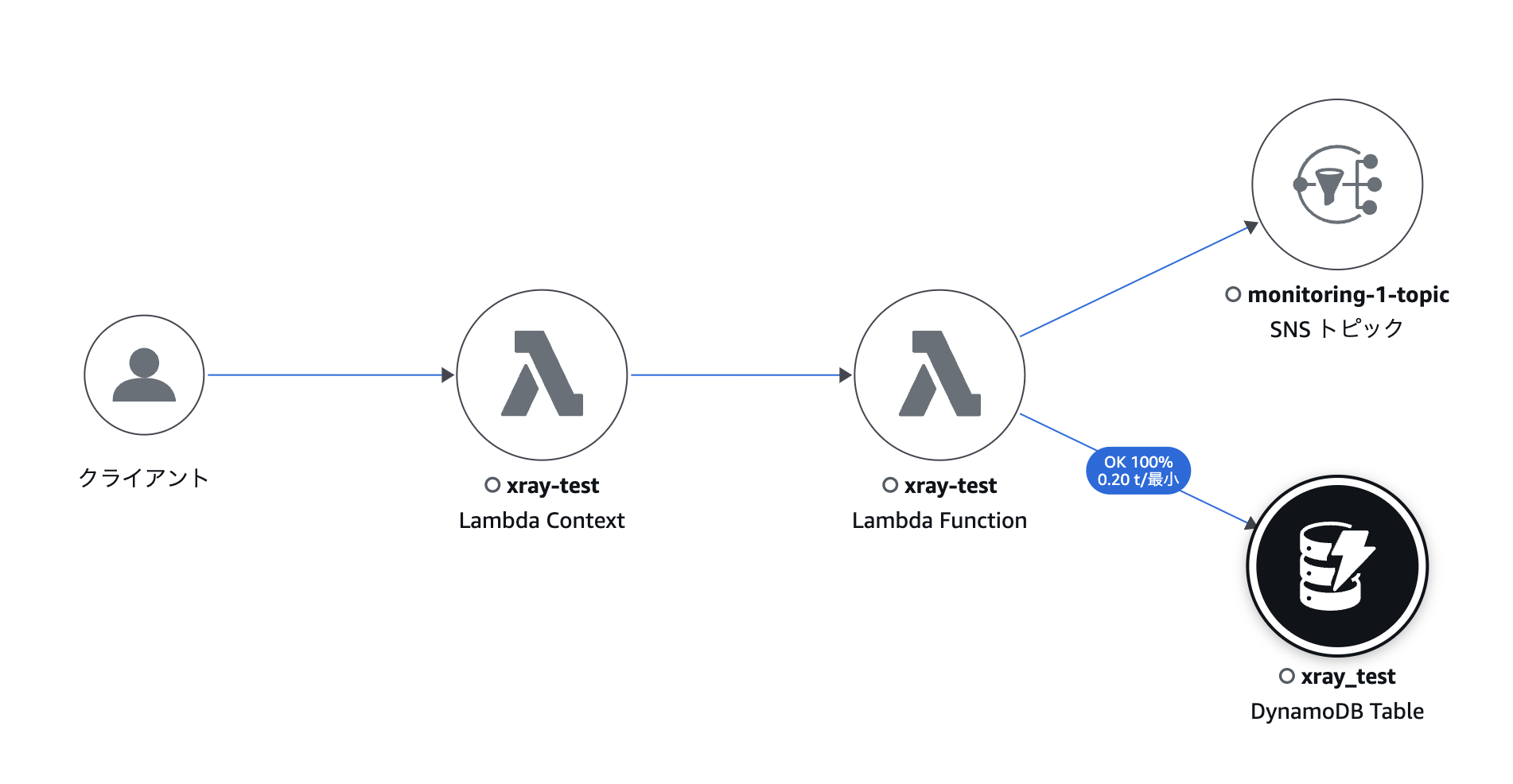はじめに
X-Rayを実際に使ったことがなく、資格取得程度の知識しかないので触ってみました。
ちょうど職場で、Java(SpringBoot)を使ったLambdaを構築していて、何故か遅い部分を調査する際に使えないかな?と思ったのがきっかけです。
早速、やってみる。
準備(テストソース)
pythonでAPIから住所を取得し、DynamoDBへの保存および、SNSトピックへ通知を行うソースを準備しました。
import os
import json
import boto3
import urllib.request
from datetime import datetime
# AWS クライアントの初期化
dynamodb = boto3.resource('dynamodb')
sns = boto3.client('sns')
# 環境変数から設定を読み込み
TABLE_NAME = os.environ['TABLE_NAME']
SNS_TOPIC_ARN = os.environ['SNS_TOPIC_ARN']
TARGET_URL = "https://zipcloud.ibsnet.co.jp/api/search?zipcode=7830060"
class ApiClient:
def __init__(self, target_url):
self.target_url = target_url
def fetch_data(self):
"""APIからデータを取得する"""
try:
with urllib.request.urlopen(self.target_url) as response:
response_data = response.read()
return json.loads(response_data.decode('utf-8'))
except urllib.error.URLError as e:
raise Exception(f"API通信エラー: {str(e)}")
except json.JSONDecodeError as e:
raise Exception(f"JSONパースエラー: {str(e)}")
except Exception as e:
raise Exception(f"予期せぬエラー: {str(e)}")
class MonitoringService:
def __init__(self, target_url, table_name, sns_topic_arn):
self.api_client = ApiClient(target_url)
self.table = dynamodb.Table(table_name)
self.sns_topic_arn = sns_topic_arn
def check_service(self):
try:
# APIクライアントを使用してデータを取得
response_body = self.api_client.fetch_data()
# 結果の保存
self.save_result(response_body)
# 結果の通知
self.notify_status(response_body)
return {
'statusCode': 200,
'body': json.dumps({
'message': 'Monitoring completed successfully',
'response_body': response_body
}, ensure_ascii=False)
}
except Exception as e:
raise e
def save_result(self, response_body):
# DynamoDBへの保存
item = {
'timestamp': str(datetime.now()),
'response_body': json.dumps(response_body, ensure_ascii=False)
}
self.table.put_item(Item=item)
def notify_status(self, response_body):
# SNS通知の送信
message = f"""
API実行結果
URL: {self.api_client.target_url}
時刻: {datetime.now()}
レスポンスボディ:
{json.dumps(response_body, ensure_ascii=False, indent=2)}
"""
sns.publish(
TopicArn=self.sns_topic_arn,
Message=message,
Subject='API実行結果'
)
def lambda_handler(event, context):
service = MonitoringService(TARGET_URL, TABLE_NAME, SNS_TOPIC_ARN)
return service.check_service()
X-Ray SDK未使用状態
X-Rayの提供する機能を十分に利用するには、X-Ray SDKを使ったコーディングが必要なのですが、まずはX-Ray SDKを使わず、Lambdaサービストレースのみを有効にした状態で動作確認してみました。
この状態だと、処理の全体所用時間や、コールドスタート時の起動処理である、initや、 ランタイムの終了処理に時間である、Overheadのみが個別に確認できます。
これだけだと、ログ見ればわかる内容ばかりなので、あまり有意義ではないかもですね。
REPORT RequestId: 49cc409d-4804-49b0-ae33-0432c31fcebb Duration: 2455.47 ms Billed Duration: 2456 ms Memory Size: 128 MB Max Memory Used: 84 MB Init Duration: 585.63 ms
XRAY TraceId: 1-679144e0-54e8508c6233db233193cfc2 SegmentId: 5a0bc1d1f3ba4822 Sampled: true
X-Ray SDK使用(セグメント未使用)
次にX-Ray SDKを使ってみます。
patch_all()だけ対応してみました。
from aws_xray_sdk.core import xray_recorder
from aws_xray_sdk.core import patch_all
# X-Ray SDKの初期化
patch_all()
patch_all()は、 X-Ray SDK for Pythonが対応したライブラリにパッチを適用し、サブセグメントとして情報を提供してくれる機能です。
この状態だと、boto3ライブラリがDynamoDBやSNSといった項目で詳細情報を提供してくれるようになりました。
DynamoDBの場合、対象テーブルや、テーブルに対してどんな操作をしたかなどもわかります。
X-Ray SDK使用(セグメント使用)
最後に、自前でセグメント、サブセグメントを使ったバージョンです。
メソッド単位や、自身で個別に測定したい範囲で性能を観測することができます。
諸々組み込んだソースは以下です。
import os
import json
import boto3
import urllib.request
from aws_xray_sdk.core import xray_recorder
from aws_xray_sdk.core import patch_all
from datetime import datetime
# X-Ray SDKの初期化
patch_all()
# AWS クライアントの初期化
dynamodb = boto3.resource('dynamodb')
sns = boto3.client('sns')
# 環境変数から設定を読み込み
TABLE_NAME = os.environ['TABLE_NAME']
SNS_TOPIC_ARN = os.environ['SNS_TOPIC_ARN']
TARGET_URL = "https://zipcloud.ibsnet.co.jp/api/search?zipcode=7830060"
class ApiClient:
def __init__(self, target_url):
self.target_url = target_url
@xray_recorder.capture('api_request')
def fetch_data(self):
"""APIからデータを取得する"""
try:
with urllib.request.urlopen(self.target_url) as response:
response_data = response.read()
return json.loads(response_data.decode('utf-8'))
except urllib.error.URLError as e:
raise Exception(f"API通信エラー: {str(e)}")
except json.JSONDecodeError as e:
raise Exception(f"JSONパースエラー: {str(e)}")
except Exception as e:
raise Exception(f"予期せぬエラー: {str(e)}")
class MonitoringService:
def __init__(self, target_url, table_name, sns_topic_arn):
subsegment = xray_recorder.begin_subsegment('MonitoringService Init')
self.api_client = ApiClient(target_url)
self.table = dynamodb.Table(table_name)
self.sns_topic_arn = sns_topic_arn
xray_recorder.end_subsegment()
@xray_recorder.capture('check_service')
def check_service(self):
try:
# APIクライアントを使用してデータを取得
response_body = self.api_client.fetch_data()
# 結果の保存
self.save_result(response_body)
# 結果の通知
self.notify_status(response_body)
return {
'statusCode': 200,
'body': json.dumps({
'message': 'Monitoring completed successfully',
'response_body': response_body
}, ensure_ascii=False)
}
except Exception as e:
raise e
@xray_recorder.capture('save_to_dynamodb')
def save_result(self, response_body):
# DynamoDBへの保存
item = {
'timestamp': str(datetime.now()),
'response_body': json.dumps(response_body, ensure_ascii=False)
}
self.table.put_item(Item=item)
@xray_recorder.capture('send_sns')
def notify_status(self, response_body):
# SNS通知の送信
message = f"""
API実行結果
URL: {self.api_client.target_url}
時刻: {datetime.now()}
レスポンスボディ:
{json.dumps(response_body, ensure_ascii=False, indent=2)}
"""
sns.publish(
TopicArn=self.sns_topic_arn,
Message=message,
Subject='API実行結果'
)
def lambda_handler(event, context):
service = MonitoringService(TARGET_URL, TABLE_NAME, SNS_TOPIC_ARN)
return service.check_service()
この状態で、X-Rayトレースを見てみると、SNS・DynamoDBに加え、各メソッドごとに指定したセグメント、特定処理部分のセブセグメントまでしっかりとトレースできています!
余談
Python版のX-Ray SDKaws_xray_sdk.coreですが、boto3みたいに標準搭載ではないので、layerでの対応が必要でしたので、下記Powertools for AWS Lambdaのlayerを使っています。
arn:aws:lambda:ap-northeast-1:017000801446:layer:AWSLambdaPowertoolsPythonV3-python38-x86_64:5
最後に
やっと実装のイメージを掴むことができました!
今までどこが遅いのんだろ?って調べる時はデバッグ用のコードを仕込んでいましたが、X-Rayを使った方法でも良いかもですね。






